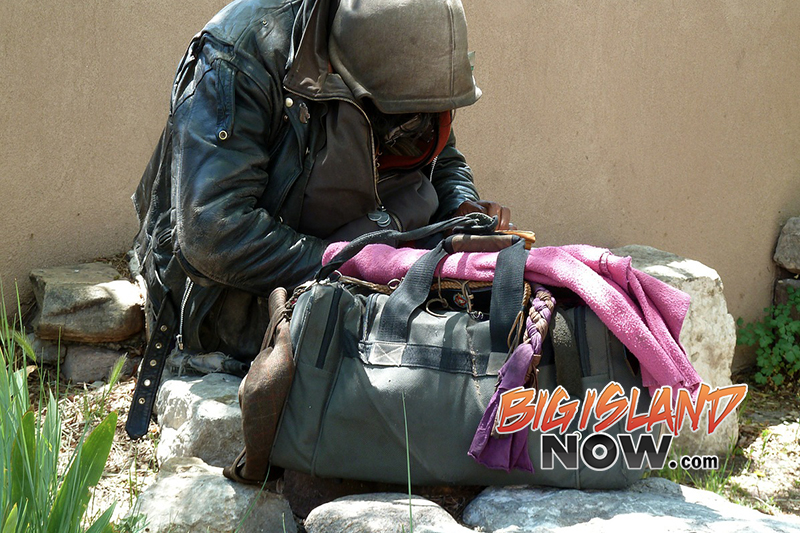Point in Time Count Shows Slight Uptick in Homeless Numbers on Big Island

The statistics say that homelessness has increased slightly on Hawai‘i Island.
Bridging the Gap, a coalition of agencies working to end homelessness on neighbor islands, released the annual Point In Time Count data on April 7, and the numbers show downward trends in some categories, although neighbor islands as a whole saw a slight increase of roughly 1% in homeless population numbers.
On the Big Island, the number of sheltered individuals counted during the count was 283, up from 227 the year before, and up from 200 in 2018. The number of unsheltered homeless counted locally was 554. That figure wasn’t available for 2021 due to the pandemic, but up from 521 in 2020 and down from the 669 in 2018.
In total, 837 persons were counted on Hawaii Island in 2022. That’ down slightly from the overall 2020 total, which was 847.
“While our total homelessness data relatively remained the same, there is still much work to do,” said Maude Cumming, Chair of Bridging the Gap, in a press release about the data. “We need to continue to invest in affordable housing, including strengthen landlord incentives like sign-up bonuses, and financial protections for repair costs of tenant-caused property damage.”
Every January, counties across the nation conduct the Homeless Point in Time Count, an annual survey of people experiencing homelessness on a given night. This year, volunteers canvassed parks, beaches, and other areas, asking people “Where did you sleep on January 23?” The federally mandated survey seeks to count anyone who slept on the street, in a car, or in other areas not meant for human habitation.
While the Point in Time Count does not capture every person experiencing homelessness, it provides a one-night snapshot of homelessness in Hawai`i, the agency explained in a news release about its findings. The data collected is compared county to county and year to year, to help stakeholders understand homelessness in their districts.
For the effort to count the unsheltered number, workers canvassed areas from Jan. 23-28.
One statistic the report shows on Hawai‘i Island is that the homeless people surveys said, for the most part, that they had been living in Hawai‘i longer than a year.
It can be a common conception for some residents on the Big Island, whether true or not, that groups or people in other states send their homeless to Hawai‘i as a way to get rid of them in their home regions because of Hawai‘i’s resources, weather, geographical isolation or a variety of other reasons.
Of the responses from the question, “Did you Move to Hawai’i within the past year?”, 483 households on the Big Island were surveyed, and 413 provided responses, good for 86% of the field. Of that total, 34 of the 413, or 8%, stated that they had moved to Hawai’i within the past year.
A breakdown of the statewide and Big Island’s figures can be accessed here.
Other neighbor island figures showed:
• Overall homelessness experienced a slight increase of less than 1%, from 2,010 persons in 2020 to 2,022 persons is 2022.
• Family homelessness decreased by 18% from 184 families in 2020 to 151 in 2022.
• Veteran homelessness decreased by 18%, from 132 veterans in 2020 to 108 in 2022.
• Unaccompanied youth homelessness declined 32%, from 62 households in 2020 to 42 in 2022.
The press release on the report also highlighted some programs that have been implemented to help combat homelessness.
This network of local non-profits in partnership with the counties launched new prevention, diversion, financial empowerment, and housing stability programs, it stated, which included a Coordination Center in the County of Hawai‘i that focused on preventing individuals and families from falling into homelessness.
The total number of homeless families as of the count date on neighbor islands was 151, the lowest it has been since 2018. That is good for a 30% reduction in family homelessness over a five-year period.
On the Big Island, the report stated, Hawai’i County continues to be successful in reducing family homelessness. The county has reduced family homelessness by 24% over the last five years with a significant reduction in unsheltered family homelessness, down 67% in the same period.
Paul Normann, executive director of Neighborhood Place of Puna and chairman of the Community Alliance Partners, said the decrease in the number of families and homeless children was an uplifting trend to see in the new data.
It speaks to the federal resources allocated to local governments to assist in housing and the efforts of local leaders like the Hawai‘i County Council that are putting homelessness as a top priority on their long-term goals.
It wasn’t certain what type of impact that pandemic would have had on the homeless situation, so the relatively flat numbers and drops in other categories is a good thing.
“Quite honestly, we expected the numbers to be much higher,” he said.
Hawai‘i County also eliminated family veteran homelessness by housing the last 3 identified families to permanent housing in 2021.
Other positive highlights for the neighbor islands include a 32% decrease in youth homelessness, and a 18% decrease in veteran homelessness.
As the neighbor island Continuum of Care, Bridging The Gap represents the counties of Hawaiʻi, Kauaʻi, and Maui, with one chapter in each of the counties.
Other notable factors for the Big Island, the report stated, is that as a result of adding shelter beds, sheltered homelessness is the highest it has been over the recent five-year period.
Sponsored Content
Comments








